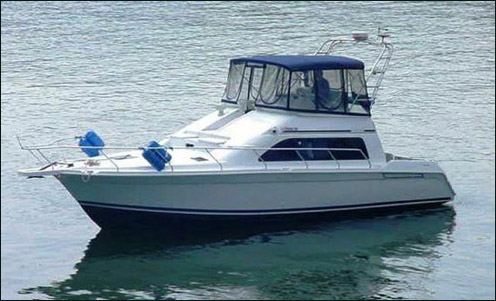 *for a whole two hours!
*for a whole two hours!
I think I'll be a sociologist in my next lifetime. I've always been intrigued by cultural conditioning and changing perspectives. Even more so when I'm the subject of the aforementioned changing perspectives.
Following are two posts on the subject. The first was made a few years ago, when I bought my 40' liveaboard boat. And, as if that wasn't enough of a perspective change, what happened the other day actually put me in the greenie class.
The topic is wind power. Like you, I've mocked, scorned and belittled it for years. What a fraud! Without fat government subsidies, it'd be as dead as geothermal energy and ocean wave power. Just another greenie notion without a lick of sense.
Until.
Wind Farm Wars
(3/23/2007)

"Beautiful, isn’t it?"
"Gorgeous. Just as God intended."
Jeez, what a doofus Ted Kennedy is, huh? "Mr. Liberal Environmentalist" doesn’t want nice, wholesome offshore wind farms in his neighborhood? This is the guy who practically spawned the term NIMBY:
Not In My Back Yard!
Now, if these things were actually going to be put just offshore, as in the above pic, we could see his gripe. None of us would like that, either. But the wind farm in question is going to be FIVE MILES offshore.
So, what’s the problem?
The problem is that Mr. Kennedy is right.
Now being the proud owner of a 40-foot boat, I now understand his beef. Real boats don’t putt along 10 feet offshore — that would be "dinghies" for those of you scoring at home. Real boats cruise much further offshore.
How much further offshore?
Oh, about 5 miles.
Away from the shallows and reefs and sand bars, in other words. If it’s low tide and I just want to putt around without panicking every time I see something in the water ahead of me, I make a beeline for deeper water.
But that’s me. What about you?
Why, there you are now! You’ve worked a lifetime to buy this terrific sailboat and you’re finally out on the ocean, wild and free! A mighty gust of wind fills the sails as you-
"LOOK OUT!"

Close one!
Just like the interstate back home.
Go ahead, razz ol’ Ted Kennedy all you want.
Just don’t start bitching and moaning when it’s your turn.
(nobody ever accused Dr. Mercury of being overly polite)
So that was one changing perspective. And then there was the other day.
The day I turned green.
I'm about to use my humble liveaboard boat...

...for what it was designed for; living off the land — as it were. I plan to spend the next three or four months 'off anchor', so my electricity will have to be self-generated. You can probably see where this is going.
And, you guessed it, the next thing I know, after years of officially mocking, scorning and belittling poor wind power, there I was on the web reading How To Build Your Own Wind Generator.
Green, baby.
By the way, have I mentioned how great wind power is? Were you aware that it's free? Imagine that! Free energy! Imagine powering the whole country with it! We could devote Kansas to the cause and simply radiate the power lines out from there. It's hard to imagine a modern, urbane country like America passing up such an opportunity. And, honestly, we don't really need Kansas, anyway. That's the advantage of having 50 states; you can afford to donate a few to good causes.
Where was I? Oh, right. Well, if anyone's interested, no, that alternator from the Buick rusting beside the garage won't work, dammit. The RPMs have to be too high before it'll generate any amount of juice. The trick is to use these certain industrial motors that have a decent RPM-to-output ratio. They're not expensive, less than $100, and you need some kind of regulator, but everything else can be done with scrap. For example, very effective wind vanes can be cut out of PVC piping using a lengthwise, curving cut.
The problem with home-made wind generation is roughly parallel to the problem commercial wind farms face: what do you do when the wind stops? In a large-scale operation, in theory you'd produce enough juice for both immediate consumption and the recharging of big industrial batteries for when the wind dies down.
The problem with the home-built units is that, while they'll pump out 12 volts for your laptop, phone charger and some small lights, they don't put out enough to adequately charge a battery. For that, you need a 120-volt battery charger, and for that you need a gasoline-powered generator. Realistically, along with the wind generator, you'd need a small generator, a great big marine battery and a big-ass charger for it. The wind generator would provide power when the wind was blowing, and the battery would take over when it wasn't.
An Unforeseen Pitfall
I read or skimmed through about five posts on the subject and watched a handful of YouTube vids, and I think about every one of the homebuilts got put out of commission at some point by the exact same thing.
Let's make you guess.
Question: The one piece of safety equipment all home-built wind generators need is:
A. A grounded lightning rod since these things act like sky magnets, especially in isolated areas without a lot of trees around
B. A fence to ward off large beasts (elk, deer, etc) who use it as a scratching post and tilt it over
C. A locking mechanism to keep it from spinning too fast in high winds, producing an overabundance of electricity and causing you to make errors as you speed up your computing endeavors so as not to waste any of it
D. A big ball made of chicken wire around the blades to keep birds from resting on them when the wind isn't blowing as the bird shit eventually weighs down the blades unevenly and causes the whole thing to vibrate apart
Actually, looking them over, those all sound pretty good. But I was thinking of 'C'. It seems like pretty much everybody's first effort gets ripped to shreds the first time it's hit with a freak wind gust. The blades spin too fast and kablooey. The commercial home units have a built-in speed limiter, but that would be tough to do for a home project. It would seem safer just to build in some kind of simple locking mechanism and not use it on days when high winds gusts were expected — although that seems kind of self-defeating since those would also be the days with the best consistent wind strength.
Since the base of the blades is the weak point, the best answer might be to simply make a spare set of blades the first time through, then use the rig like normal. Should a freak gust snap off all or some of the blades, at least it won't be a huge undertaking to repair it, plus you'll have some valuable meteorological data to warn you about next time. That is, you'd have a number of weather sites on tap and as soon as the destructive gust hit, you'd go to them all and one might possibly have some kind of "gust warning" posted, so you'd pay more attention to that site in the future.
I won't be building a wind generator, myself, because the boat's already loaded with batteries, chargers and inverters, but I was curious as to what the process entailed. While I was disappointed that a car alternator & regulator wouldn't work (the cheapest method, by far), it was nice to see that the unit wouldn't cost a lot, assuming you can do most of the work yourself. For a remote cabin getaway — combined with a small generator/battery combo — it would be an interesting, worthwhile project.


 *for a whole two hours!
*for a whole two hours!

